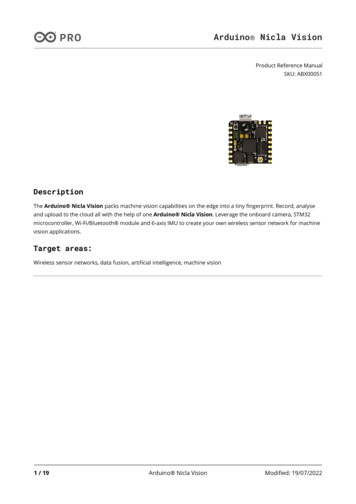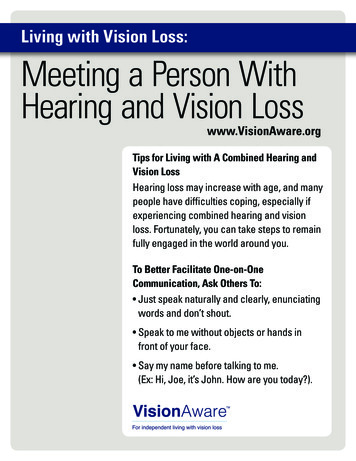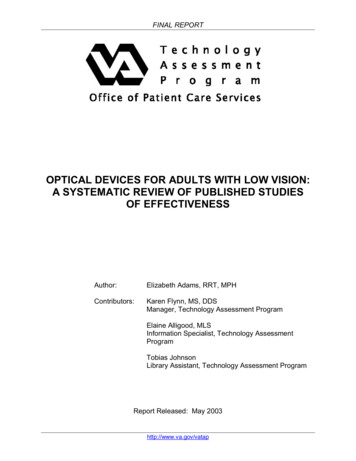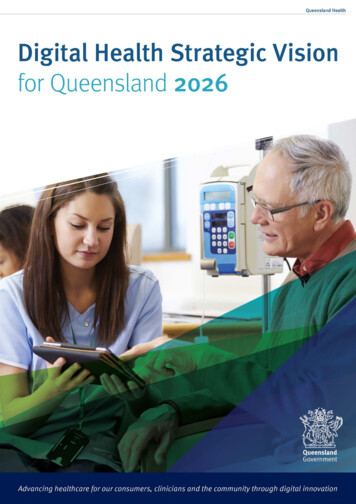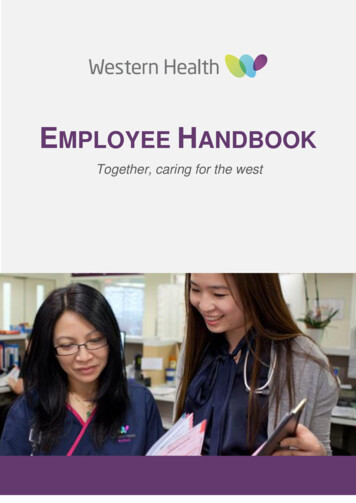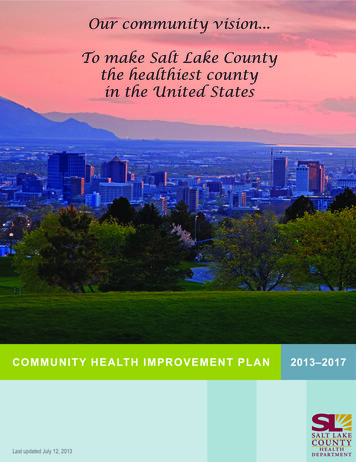
Transcription
Our community vision.To make Salt Lake Countythe healthiest countyin the United StatesCO MMUNIT Y HE ALT H I M P R OV EME N T PL A NLast updated July 12, 20132013–2017
TRANSMITTAL LETTER . 2EXECUTIVE SUMMARY . 3INTRODUCTION . 6Community Health Assessment Background . 6Description of the CHIP Process . 7The MAPP Process . 8PROGRESS TO DATE AND PLANNED FUTURE ACTIONS . 9Alignment of the CHIP and State and National Priorities .10National Priorities .10State Priorities .11CHIP AND THE PATIENT PROTECTION AND AFFORDABLE CARE ACT .11WORKGROUP PROJECTS .13Priority Area #1: Air Pollution .13Air Pollution Data from CHA .13Organizations Involved.13Project Descriptions .14Alignment with State Priorities.14Alignment with National Priorities .15Policy Changes Needed.15Priority Area #2: Water Quality .15Water Quality CHA Data .15Organizations Involved.15Project Descriptions .15Alignment with State Priorities.17Alignment with National Priorities .17Policy Changes Needed.17Priority Area #3: Chronic Disease and Obesity .18Chronic Disease Data from the CHA .18Organizations Involved.18Project Descriptions .19Alignment with State Priorities.21Alignment with National Priorities .22Policy Changes Needed.22
Priority Area #4: Infectious Disease .22Infectious Disease Data from CHA .22Organizations Involved.23Project Descriptions .23Alignment with State Priorities.25Alignment with National Priorities .25Policy Changes Needed.25Priority Area #5: Maternal and Child Health .26Maternal and Child Health Data from CHA .26Organizations Involved.26Project Descriptions .26Alignment with State Priorities.28Alignment with National Priorities .28Policy Changes Needed.29Priority Area #6: Mental Health and Substance Abuse .29Organizations Involved.30Project Descriptions .30Alignment with State Priorities.31Alignment with National Priorities .31Policy Changes Needed.31CONCLUSION AND RECOMMENDATIONS .32Process Changes Needed to Accomplish Objectives .32Policy Changes Needed to Accomplish Objectives .32Invitation .33APPENDIX A .34Individuals Involved in MAPP Priority Workgroups .34
How can a single individual stem the tide of obesity in Salt Lake? How could oneorganization change the way mental health issues are perceived and responded to by anentire county? It may not be possible for a singular force to influence the multi-facetedhealth problems Salt Lake County (SLCo) faces; however, if those fighting for changecoordinate their efforts, a change could be made.In response to these complex problems, a collaborative and focused approach is underwayto improve the health of SLCo and its residents. Representatives of local and stategovernment agencies, social service organizations, non-profit organizations, universities,local businesses, hospitals, and concerned community members have banded together toprovide their expertise, resources, and influence.As in many other areas, the health needs of SLCo residents far outstrip capacity. However,much progress can be made by working together with committed community partners onspecific projects. We can leverage our resources and improve our product by workingjointly as community partners on common issues. By leveraging our resources, and throughcreative collaborations with partners, duplication of services can be reduced enablingprograms to reach a greater number of SLCo residents.This Community Health Improvement Plan is the second logical step in a three stepprocess. Initially we conducted a Community Health Assessment based on both qualitativedata and quantitative date. Focus groups were conducted with residents from sixgeographic areas in the county, community, professional and business partners, andrepresentatives from three ethnic groups. Focus groups were recorded, transcribed, andanalyzed. Upon review of the results, themes and constructs were developed that provideda model to better understand the individual, system, and environmental factors influencinghealth in SLCo. In addition we reviewed demographic and health data on critical indicators.The data was analyzed by comparing the small areas within SLCo to each other, the countyas a whole, the state, and the nation using HP 2020 targets as benchmarks.We intend this plan to be a community health improvement plan, not a Salt Lake CountyHealth Department improvement plan. Although the SLCoHD is taking the lead to initiatethis process, the intent is to join with other community partners to determine needs,identify resources, and develop joint strategies to meet those needs.Stephen Alder, PhDChair, MAPP Steering CommitteeJuly 30, 2013
On October 18, 2012 the Salt Lake County Health Department transitioned from thecompleted Community Health Assessment (CHA) to the next phase: the development of aCommunity Health Improvement Plan (CHIP). Now that the data have been analyzed, weneed to put it to good use.Building upon our collaborative efforts during the CHA, we invited the participants fromprior focus groups (over 200 individuals representing residents, health professionals,special interest groups, educators, health insurance companies, policy makers, clergy,funders and elected officials), to the initial CHIP planning meeting held October 18, 2012.The first item on the agenda was sharing the results of the CHA. The participants wereasked to continue their active involvement by participating in workgroups related to thepriority areas identified in the CHAEach workgroup was asked to discuss projects their agencies are currently or planning towork on; identify who else should be included in the workgroup; brainstorm projects theycould collaboratively undertake; and select two projects they believe they could complete.Some of the groups noted they are already participating with other community groups andrecommended that we build on and further existing work. The workgroups and theirprojects are more fully discussed in the body of this plan. The workgroup process waslargely successful, as diverse participants noted similar interests and projects. Some of thegroups are continuing to meet; each group has reached out to the broader community forsupport. Workgroup members also identified a lack of communication among the variousgroups. For example, one workgroup identified four projects, all targeting the same schooland no one knew of the others’ existence.As should be expected some workgroups are further along than others. In addition, eachgroup has adopted a slightly different model in their approach; some prefer to initiate newinitiatives while others plan to work with established collaborations.The six priority areas and planned projects are as follows:Air Pollution Project 1: Implement a public education campaign addressing mobile sources. Project 2: Implement the What’s My Impact? program for non-point sources.Water Quality Project 1: Maintain Salt Lake County septic systems. Project 2: Reduce human and animal waste contamination. Project 3: Address standing water in Salt Lake County.
Project 4: Address water hazards in Salt Lake County.Chronic Disease and Obesity Project 1: Promote active transportation.Project 2: Promote healthy food availability among underserved populations.Project 3: Improve physical education environments in Salt Lake County Schools.Project 4: Improve Salt Lake County school eating environments.Infectious Disease Project 1: Determine adult (ages 19 ) immunization for coverage of Tdap and Influenzavaccines. Project 2: Provide vaccine information at the Salt Lake County agency new hireorientations. Project 3: Partner with current workgroups who are working with school districts tohave an adult immunization requirement. Project 4: Evaluate current immunization campaigns.Maternal and Child Health Project 1: Promote a healthy post-partum weight in mothers and children.Project 2: Promote a healthy pregnancy.Project 3: Promote preconception health.Project 4: Promote culturally appropriate outreach.Mental Health and Substance Abuse Project 1: Improve school-based mental health education. Project 2: Increase UNI CrisisLine awareness among first responders. Project 3: Provide multi-lingual mental health services.To help maintain the momentum created by the workgroups, the SLCoHD implemented acommunity-driven planning process entitled Mobilizing for Action through Planning andPartnerships (MAPP) to foster cooperation and collaboration among partners. The firststep in this process was to form a Steering Committee composed of area leaders. TheSteering Committee is composed of the following people: SLCo Board of Health member and the University of Utah Graduate Programs in PublicHealth director (Chair) United Way of Salt Lake senior vice president of collective impact (Co-Chair) Sandy City Healthy Communities chairman (a grassroots organization of committedcitizens working to improve their community)
Utah State Representative (representing one of the municipalities with many healthneeds) Community Health Center director Intermountain Health Care CEO of the Urban Central Division(a non-profit health caresystem) Salt Lake County Department of Human Services deputy director & Calvary BaptistChurch Pastor Salt Lake County Diversity Director Murray School District Assistant SuperintendentMembership on the Steering Committee will be modified as needs change. The Committeehas met twice, is scheduled to meet in September 2013, and tentatively plans to meetquarterly. The committee has the charge to oversee and guide the workgroups, facilitatethe MAPP process, and assist in the implementation of the Community HealthImprovement Plan.Quality Improvement (QI), a systematic approach to improving agency processes, and afunctioning CHIP go hand in hand. The SLCoHD officially adopted QI as a major initiativeand has, as of this writing, completed over ten projects. We see QI as a powerful tool to helpimprove processes.The goal of any plan is to describe and guide actions that will lead to the intended change.The CHIP’s goal is to stimulate and drive action. Although not fully implemented, the SLCoCHIP is already having an impact. For example, the implementation of a MAPP process,forming functioning workgroups, increased community partnerships, and an active QIprocess are evidence that the SLCo Community Health Improvement Plan is having animpact and is being implemented.
How can a single individual stem the tide of obesity in Salt Lake? How could oneorganization change the way mental health issues are perceived and responded to by anentire county? It may not be possible for a singular force to influence the multi-facetedhealth problems Salt Lake County (SLCo) faces; however, maybe if those fighting for changecoordinate their efforts a change could be made.In response to the complex problems identified by aCommunity Health Assessment, a focused collaborativeapproach has been undertaken to improve the health ofSalt Lake County residents. Partners from governmentagencies, social services, non-profits, universities,businesses, hospital systems, faith-based groups, andconcerned community members have banded togetherto provide their respective expertise, resources, andinfluence.“Never doubt that a small groupof thoughtful, concerned citizenscan change the world. Indeed it isthe only thing that ever has.”-- Margaret MeadUtah is generally a very healthy state. Salt Lake County, Utah’s largest county, accounts forabout 40 % of the population. Although Salt Lake County is generally healthy, there aresome areas that are healthier than others; where you live can impact how long you live andthe quality of that life. For example, the average life expectancy in Salt Lake County rangesfrom a high of 84.3 years in the Foothill/University of Utah area to a low of 74.5 years inthe South Salt Lake area, a short six miles away.The mission of this plan is twofold. First, the Community Health Improvement Plan willutilize the data generated from the Community Health Assessment to strategically focus onpublic health problems that impact the county as whole as well as unique challenges thataffect specific neighborhoods and secondly, provide a catalyst for community partners towork together on mutually beneficial projects.Between 2010 and 2012, the SLCoHD formed a team with the goal to combine theirknowledge, insights, and experience to create Salt Lake County’s first comprehensiveCommunity Health Assessment, known as the CHA. The CHA was created through “acollaborative process of collecting and analyzing data into information for use in educatingand mobilizing communities, developing priorities, garnering resources, and planningactions to improve the population’s health”.1Input was sought from the community at large including neighborhood leadership,community residents of various ages and ethnicities, and partners who provide services to1Public Health Accreditation Board. "Public Health Accreditation Board: Standards & Measures Version1.0." phaboard.org. andards-and-MeasuresVersion-1.0.pdf (accessed July 2, 2013).
the community. Partners included elected officials, health care providers, employers,religious leaders, and representatives from charitable foundations, communityorganizations, ethnic organizations, nursing schools, emergency response, andenvironmental health. See Appendix A for a full list of participants.In total, 22 focus groups were conducted with over 200 participants from six sections of thecounty. To enhance diverse perspectives initially missing from the focus groups threeadditional focus groups were conducted: Refugee, Spanish Speaking, and Native American.The partner community leader focus groups were the largest and were used to determinethe priority areas as we moved forward. Two focus groups were held with communityleaders. The charge of the first focus group was to identify and discuss public health issues.Eighty-six people attended representing a wide array of partners, including city mayors,representatives from clinics serving low income residents, educators and students frommajor universities, a dentist, and a wildlife biologist. The second meeting, one month later,was designed to distill the numerous issues identified during the first community andpartner focus groups to a manageable number; prioritize the issues, and begin to identifysolutions to the issues. This meeting was attended by 58 professionals, many from the firstparticipant focus groups. At this meeting the group identified six priority areas.Prioritization was accomplished using a cumulative voting process. The six priority areasidentified are Air PollutionWater QualityChronic Disease and ObesityInfectious diseaseMaternal and Child HealthMental Health and Substance AbuseThese became the areas of focus as we transitioned into the development of thisCommunity Health Improvement Plan (CHIP).The CHA has and will continue to guide the work undertaken by these workgroups. A copyof the CHA can be found on the Salt Lake County Health Department’s website athttp://www.slcohealth.org/pdf/2013CHA Final.pdf, and will be updated in three years.As the CHA report neared completion, we transitioned into development of the CHIP. Tofacilitate the transition we organized a third meeting, and invited all of the participantsfrom the prior meetings and others as appropriate. The first half of the meeting wasdevoted to a discussion of the findings from the CHA, the second half focused on initiatingthe workgroups and beginning open communication and collaboration with ourcommunity partners.
Participants self-selected into workgroups and were given the pertinent sections of theCHA to help inform their decisions about their goals and objectives. The workgroups wereasked to identify any collaborative projects they were currently working on, brainstormand prioritize potential collaborative projects, and identify any other potential partnersthat were not represented.The MAPP process is just beginning. Two meetings have been held. During the first meetingthe Steering Committee members were oriented to the MAPP process; during the second,members were oriented to each workgroup’s progress. As the process matures, ouroverarching goal is to have self-sufficient groups of community partners, assisted bySLCoHD subject matter experts and administrative support, working together to amelioratehealth problems in Salt Lake County under direction of a steering committee of communityleaders.The strategy selected to achieve this goal is the Mobilizing for Action through Planning andPartnerships (MAPP) process. MAPP is a community-driven planning process to improvepublic health. Priority Area Workgroups will actively communicate, collaborate, andcoordinate with area partners regarding resources and programs to minimize duplicationand maximize use of limited resources. A steering committee of community leaders hasbeen placed in charge of managing and guiding the work done by the various workgroups.The roles of the Steering Committee include: Planningo Attend meetingso Brainstorm approaches to implementing MAPP in the communityo Identify entities responsible for conducting the MAPP Processo Identify resources Marketingo Publicize the accomplishments of the MAPP workgroupso Recruit new partner organizations and community members Implementationo Hold regular meetingso Oversee workgroupso Provide support and resources as neededThe MAPP Steering Committee is designed to be a high level organization composed of arealeaders. We are attempting to increase the membership in the Steering Committee tobroaden the sectors represented. Membership will be adjusted over time, based onexpertise to support projects chosen by the workgroups. Currently, the Steering Committeeis composed of the following people:
Stephen AlderGordon JohnsonDexter PearceUniversity of Utah GraduatePrograms in Public HealthHealthy Sandy PartnershipCommunity HealthCenters IncorporatedBill CrimRoderic LandAngela RomeroUnited WaySalt Lake CountyCalvary Baptist ChurchUtah State LegislatureLarry HancockRobert McDanielRebecca SanchezIntermountain HealthcareMurray School DistrictSalt Lake County Centers, Inc.Together, the workgroups and steering committee form a diverse and powerful groupaiming to improve the health of Salt Lake County residents. The organizational structure ofthese groups can be seen in Figure 2.Figure 2. Organizational structure.Steering CommitteeAir PollutionInfectiousDiseaseMaternal andChild HealthMental Healthand SubstanceAbuseObesity andChronic DiseaseWater QualityAlthough workgroups were lead initially by SLCoHD staff, the goal is to have communitypartners emerge and assume responsibility for leadership of the workgroups. However,SLCoHD staff will continue to be active participants throughout the process.In addition to the actions taken to implement initiatives from the individual projects, therehave been a number of actions taken related to implementing the MAPP process. Theseactions will be discussed in the narrative for each project below. This effort has, in manyways, helped the SLCoHD to further develop collaborations with partners. Recognizing theneed to collaborate and work more closely with our partners is perhaps the single mostsignificant evidence of progress spurred by the development of this effort. In addition thisprocess has stimulated a change in the way we do business. Specifically the activities thathave been implemented include the following: Formed workgroups composed of community partners with the goal to workcollaboratively on identified, do-able projects. Implemented a MAPP Process.o Organized a steering committee composed of community leaders to oversee theworkgroups.
o Trained the Steering Committee on the MAPP process.o Held two meetings to date. Implemented a Quality Improvement (QI) Process.o Completed six QI projects, the most significant of which is a review of the cultureof quality which revealed issues associated with communication and trust. Thoseissues are now being worked on. Furthermore, an additional 12 projects areunderway.o Identified, by each division, a minimum of two projects to complete.o Formed a QI Council, with each division represented by two employees servingstaggered two year terms.o Trained selected staff on QI methods.o Developed a QI Council charter.o Assigned the Department’s upper management team to oversee QI process. Implemented a City Liaison Program. Management staff has been assigned to workdirectly with the Mayor of their city or a nearby city. This effort has improvedcommunication between the Department and the cities, as now each Mayor personallyknows who they can contact for immediate public health assistance.We believe that all of these initiatives and those of the workgroups will have a positiveimpact on the health of Salt Lake County residents.National PrioritiesIn developing the CHA we relied heavily on three documents to examine how Salt LakeCounty compares with other counties in the state and nationally. The first two are primaryreport cards. The third, Healthy People 2020 (HP2020) provided objectives and targetswhich served as benchmarks for what rates the county should aspire to attain. Using theIndicator Based Information System for Public Health (IBIS-PH)2 data sets, we comparedour Small Areas3 to the national HP 2020 targets identifying those Small Areas thatexceeded or lagged behind the national target. These comparisons were instrumental inproviding insight into public health issues in the county and to identify Small Areas of thecounty struggling with specific challenges. As such, the comparisons were instrumental inguiding the CHIP. The challenges identified became the Priority Areas for intervention forthe CHIP workgroups. Knowing what problems exist where allows us to better strategicallydevote resources to the areas of most need.2IBIS-PH is the premier data resource in Utah. Data are published on the web as “Indicator Reports” that provide online numerical data for HP 2020 objectives as well as its public health context (current status and interventions). Inaddition, “custom queries” can be done. Staff members are available to assist if needed. Data are updated as newinformation is received. Data obtained for the health indicators chosen for analysis in the CHA were obtainedprimarily from IBIS-PH.3Small Areas are defined as a unit of data analysis that allows examination of data specific to a geographic orgeopolitical area. Variables defining small areas may include population, city boundaries, etc. Salt Lake has 24defined small areas.
Report Cards: Community health status was analyzed using two “report cards”, theDepartment of Health and Human Services Community Health Status Indicator (CHSI)Project and the Robert Woods Johnson County Health Rankings and Roadmaps (CHRR)Project. The former examines all U.S. counties on 200 health indicators and comparesthem to peer counties. Their report identifies areas of excellence and areas forimprovement. For counties in Utah, the latter compared data for various measures to anaverage score of the top 10% of counties in the nation. Healthy People 2020: The HP 2020 objectives provided the backbone of the CHA. Thefindings for Salt Lake County on each health indicator chosen were compared to its HP2020 objective. IBIS-PH: IBIS-PH Data elements are reported by county, local health district, and SmallAreas. Graphs based on IBIS data were developed for each health indicator with SmallAreas, and county, state, and national rates highlighted to indicate scores below orabove the HP 2020 target. When necessary, data not available by Small Areas waspresented by Heath Districts.State PrioritiesThe Utah Department of Health has four overarching goals for its Strategic Plan. The first is“Healthiest People.” This goal is consistent with the Salt Lake County Health Department’svision “To make Salt Lake County the healthiest county in the United States”. The UDOHStatewide Health Improvement Plan lists four goals:1.2.3.4.Healthy eating; active living (to reduce obesity)Immunizations throughout the lifecycleA unified and effective public health systemAdequately funded public health systemThe first two align directly to Priority Initiatives identified by the Priority AreaWorkgroups 3 (Chronic Disease / Obesity) and 4 (Infectious Disease). Goal 3, a unified andeffective public health system over arches all of the Priority Initiatives discussed in thisdocument.Many opportunities exist for local health departments and community partners to improvethe h
Salt Lake County, Utah's largest county, accounts for about 40 % of the population. Although Salt Lake County is generally healthy, there are some areas that are healthier than others; where you live can impact how long you live and the quality of that life. For example, the average life expectancy in Salt Lake County ranges
